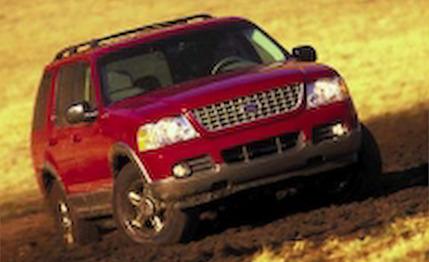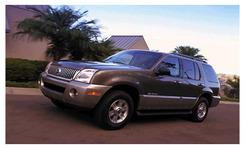 First Drive Review
First Drive Review
Driving the current Ford Explorer is about as electrifying as reading the Uniform Commercial Code backward. The Ranger-derived ute is crude, it's ponderous, and it guzzles harder than a yeoman on leave in Bangkok. Yet it seems as though you can't swing a wet nappy these days without hitting one. Since the Explorer's launch in 1990, Ford has carpeted American byways with 3.5 million of them and added another 430,000 to the shag pile last year alone.
With the 2002 five-door Ford Explorer and Mercury Mountaineer, Ford will not convert all of the remaining nonbelievers. But with this extensive redesign, the company has turned up the voltage enough to jolt their attention. Just assigning Manfred Rumpel to the engineering team earns Ford a gold star.
Rumpel is a former Porsche chassis engineer with a resume that includes helping develop the Porsche 917 for Le Mans and Can-Am. Think Mark Donohue and 1000 horsepower. Rumpel joined Ford 20 years ago and oversaw the design of the Lincoln LS suspension, arguably that car's best feature. The LS served as inspiration for the '02 Explorer and Mountaineer's new all-independent suspension, without which many of the truck's most significant upgrades wouldn't be possible. They include an optional third row of seats, a larger cabin, and better road manners.
"The suspension concept is the same as that used on many luxury cars," Rumpel says. "The challenge was to meet all the requirements of a truck -- more ground clearance, higher [weight] loads, off-road handling -- and still make it fun to drive."
Up front, the ancient torsion bars are gone, replaced by two pairs of independent control arms bolted to aluminum knuckles and braced by coil-over shock assemblies. The IRS has cast-aluminum upper and beefy stamped-steel lower control arms with cast-iron knuckles and toe-control links. Visteon supplies the aluminum pumpkin and its cogged internals, which for safekeeping are mounted 0.8-inch higher than the old iron-case differential and shielded by skid plates.
Despite larger disc brakes all around (12.0 inches forward, 11.9 inches aft), rear unsprung weight drops from about 400 pounds with the old live axle to about 100 pounds, says Rumpel. The new rear suspension has eight times the lateral stiffness of the live axle, he says. From empty up to the full 1500-pound payload capacity, the Explorer's rear camber change is just 1.8 degrees, and toe changes are virtually nil. That should help preserve the Explorer's sharper handling regardless of how much gear is piled in back. However, the suspension does contribute to an overall weight increase for the Explorer of about 200 pounds.
Since the IRS eliminates the traditional rear-frame kickup that is required in most trucks for axle travel, more gear will fit in back. By running the frame rails flat around the differential (the half-shafts poke through conical tunnels in the rails), Ford was able to lay the rear cabin floor a handy seven inches lower than in the old model. The IRS also helps reduce cabin intrusion by the rear wheel wells. With the middle row folded and the third bench absent, cargo volume rises by 6 cubic feet to 88.
Overall, the new Explorer/Mountaineer is 1.9 inches wider and has more generous leg, hip, and shoulder room for front- and middle-row passengers. Headroom remains essentially unchanged (the roof stamping is one of the few carry-over parts). An inflatable window curtain that deploys from the roof to protect against side impacts will be standard at launch. Within a year, Ford will offer an optional curtain with additional electronics that inflate the bag during rollovers, too.
The Explorer had to be wider to accommodate the taller cylinder heads of Ford's 4.6-liter SOHC V-8. After 32 years in the Ford catalog, the 4.9-liter pushrod V-8 becomes a faded memory unless you live in Australia, where the 302 is still offered in the domestic Ford Falcon sedan.